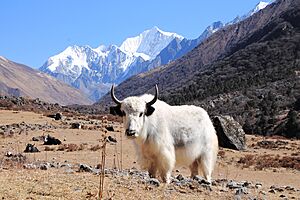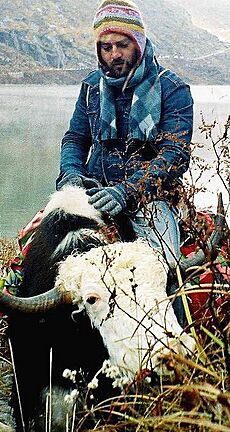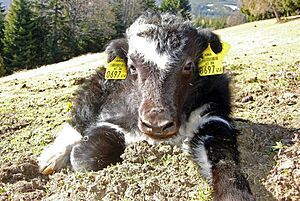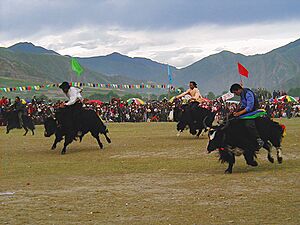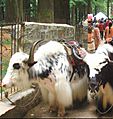Yak facts for kids
Quick facts for kids Yak |
|
|---|---|
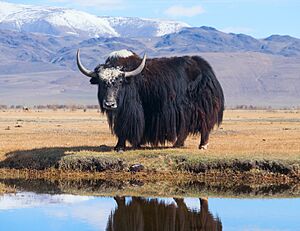 |
|
| A yak near Chagan-Uzun, Altai Republic, Russia | |
| Conservation status | |
| Scientific classification | |
| Synonyms | |
|
Poephagus grunniens |
The yak (scientific name: Bos grunniens) is a type of long-haired domesticated cattle. You can find them across the Himalayan region, the Tibetan Plateau, Tajikistan, the Pamir Mountains, and even as far north as Mongolia and Siberia. Yaks are descendants of the wild yak (Bos mutus). People also call them the Tartary ox or grunting ox because of the sounds they make.
Contents
Where Does the Word "Yak" Come From?
The English word yak comes from the Tibetan word Tibetan: གཡག་, Wylie: g.yag. In Tibetan and Balti, this word only refers to the male yak. Female yaks have different names, like Tibetan: འབྲི་, Wylie: bri or Tibetan: གནག, Wylie: gnag in Tibetan. But in English, we use "yak" for both male and female animals. If we need to be specific, we say "yak bull" for males and "yak cow" for females.
Yak Family Tree: How Yaks are Related to Other Animals
Yaks belong to the group of animals called Bos, which also includes regular cattle (Bos primigenius). Scientists have studied yak DNA to understand their history. They think yaks might have separated from cattle between one and five million years ago. Some even suggest yaks could be more closely related to bison than to other cattle.
The scientific name Bos grunniens ("grunting ox") was first given to yaks in 1766. Today, this name usually refers to the domesticated yak. The wild yak is called Bos mutus ("mute ox"). Even though some people still see the wild yak as a type of Bos grunniens, it's now more common to use Bos mutus for wild yaks.
What Do Yaks Look Like?
Yaks are strong, heavily built animals. They have big bodies, sturdy legs, and rounded hooves. Their most noticeable feature is their extremely thick, long fur, which hangs lower than their belly. Wild yaks are usually dark, from black to brown. Domesticated yaks, however, can have many colors, often with rusty brown and cream patches.
They have small ears and wide foreheads. Their horns are smooth and usually dark. Male yaks (bulls) have horns that sweep out from their head and then curve backward, growing up to about 99 cm (39 inches) long. Female yaks (cows) have smaller horns, about 64 cm (25 inches) long, that point more upright. Both male and female yaks have a short neck with a noticeable hump on their shoulders, which is bigger in males.
Male yaks weigh about 350 to 585 kilograms (770 to 1,290 pounds). Females are lighter, weighing about 225 to 255 kilograms (495 to 560 pounds). Wild yaks can be much heavier, with males reaching up to 1,000 kilograms (2,200 pounds). Domestic yak males stand about 111 to 138 cm (44 to 54 inches) tall at the shoulder, while females are 105 to 117 cm (41 to 46 inches) tall.
Their long, shaggy hair and a thick, woolly undercoat keep them warm in the cold. In males, this fur can form a long "skirt" that almost touches the ground. Unlike cattle, their tail is long and looks like a horse's tail. Domesticated yaks can be white, grey, brown, or even have mixed colors. Female yaks have small, hairy udders with four teats, protected from the cold.
Yaks don't moo like regular cattle. Instead, both wild and domestic yaks make grunting and squeaking sounds. This is why the domestic yak's scientific name is Bos grunniens, meaning "grunting bull." The wild yak's name, Bos mutus, means "silent bull," but they do make sounds too!
How Yaks Survive in the Cold Mountains
Yaks are perfectly built for living in high mountains. They have larger lungs and hearts than cattle that live in lower areas. Their blood is also better at carrying oxygen throughout their bodies. This helps them breathe easily where the air is thin. However, yaks don't do well in warm weather and can get sick if the temperature goes above 15°C (59°F).
To stay warm, yaks have a thick layer of fat under their skin and hardly any working sweat glands. This means they don't sweat much, which helps them keep their body heat.
Compared to domestic cattle, yaks have a very large stomach (specifically, their rumen). This allows them to eat large amounts of low-quality food at once and digest it for longer to get more nutrients. Yaks only need to eat about 1% of their body weight daily to stay healthy, while cattle need 3%. They are herbivores, meaning they eat plants. Wild yaks mainly eat grass and sedges, along with some herbs and small shrubs.
Yak Reproduction and Life Cycle
Yaks usually mate in the summer, between July and September. For the rest of the year, male yaks (bulls) often live in small groups away from the larger herds. But as mating season approaches, they become more aggressive. They fight each other to show who is strongest. They might bellow, scrape the ground with their horns, or charge at each other. Like bison, male yaks roll around in dry soil during this time, often marking the area with their urine or dung. Female yaks can be ready to mate up to four times a year, but they are only receptive for a few hours each time.
A female yak's pregnancy lasts between 257 and 270 days. This means calves are usually born in May or June. The mother yak finds a quiet place to give birth. A newborn calf can walk within about ten minutes of being born, and then the mother and calf quickly rejoin the herd. Female yaks, both wild and domestic, usually give birth only once every two years. However, if there's plenty of food, they might have calves more often.
Calves stop drinking their mother's milk (they are weaned) at about one year old and become independent soon after. Wild calves are born brown and later grow their darker adult fur. Female yaks usually have their first calf when they are three or four years old. They are most fertile around six years of age. Yaks can live for more than twenty years when domesticated or in zoos, but they might live a bit less in the wild.
How Yaks Help People: A Partnership for Thousands of Years
For thousands of years, people in Mongolia and Tibet have kept domesticated yaks. Yaks are very important to them. They provide milk, fiber (wool), and meat. They are also used as pack animals to carry goods. Their dried droppings are a crucial fuel source, especially on the high, treeless Tibetan Plateau, where other fuels are hard to find.
Yaks carry goods across mountain passes for farmers and traders. They are also popular for climbing and trekking trips. Yaks are special because they don't eat grain; they need grass to survive long journeys. They are also used to pull ploughs in fields.
Yak milk is often made into a cheese called chhurpi in Tibetan and Nepali, or byaslag in Mongolia. Butter made from yak milk is a key ingredient in the butter tea that Tibetans drink a lot. This butter is also used in lamps and shaped into butter sculptures for religious events.
Yaks Around the World
Small groups of yaks can also be found in the United States, Canada, New Zealand, and parts of Europe. People outside the Himalayas are interested in yaks for commercial reasons and for breeding with other cattle. In North America, yak breeders mainly focus on producing lean meat by crossing yaks with other cattle. They also raise yaks for their wool.
Learning More About Yaks: Research Efforts
The Indian government started a special center in 1989 to research yak farming. It's called the ICAR-National Research Centre on Yak, located in Dirang, Arunachal Pradesh. They have a yak farm at an altitude of 2,750 meters (9,020 feet) to study yaks.
Mixing Yak Breeds: Hybrids
In Nepal, Tibet, and Mongolia, domestic cattle are often crossbred with yaks. This creates new animals:
- Male offspring are called dzo (མཛོ།). These males cannot have babies.
- Female offspring are called dzomo or zhom (མཛོ་མོ།). These females can have babies and can be crossed again with cattle.
One type of cattle in Nepal, the Dwarf Lulu breed, has DNA from both regular cattle and yaks. However, the offspring from second-generation yak-cattle crosses are not very productive, so they are mainly raised for meat.
Yaks have been successfully crossed with other animals too, like American bison (creating a "yakalo"), gaur, and banteng. The results are generally similar to those with domestic cattle.
When Did Yaks Become Domesticated?
People have been crossbreeding yaks and domestic cattle in China for at least 2,000 years. The oldest physical proof of yak domestication dates back about 2,500 years ago. This shows that yaks have been important partners to humans for a very long time.
Yak Traditions and Fun Activities
In some parts of Tibet and Karakorum, yak racing is a popular form of entertainment at traditional festivals. It's an important part of their culture. More recently, sports like yak skiing or yak polo are being offered as tourist attractions in South Asian countries, including Gilgit-Baltistan, Pakistan.
Traditionally, yaks are used to transport deceased people to special outdoor burial sites in Tibet. After their important task, these yaks are set free.
Gallery
-
Yaks in Gilgit-Baltistan, Pakistan
See also



